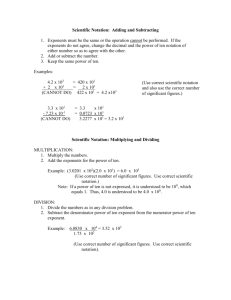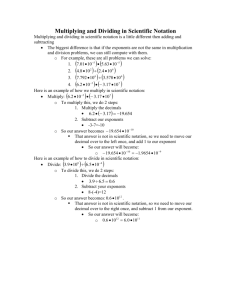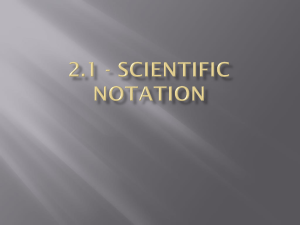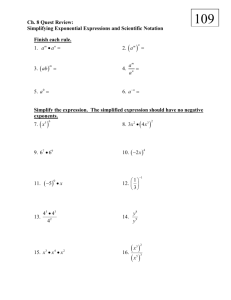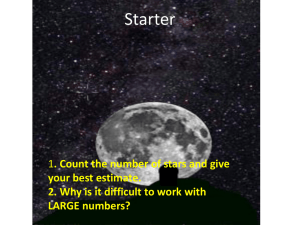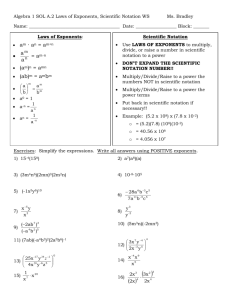Unit #1
advertisement
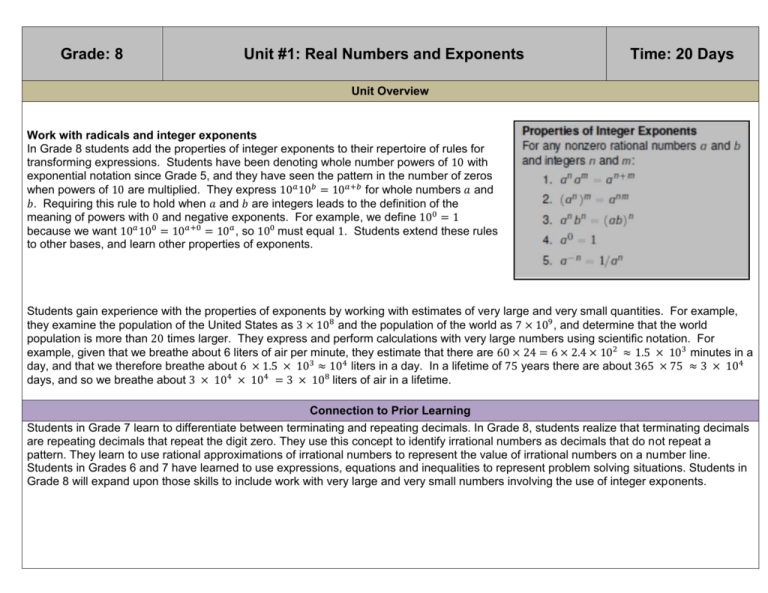
Grade: 8 Unit #1: Real Numbers and Exponents Time: 20 Days Unit Overview Work with radicals and integer exponents In Grade 8 students add the properties of integer exponents to their repertoire of rules for transforming expressions. Students have been denoting whole number powers of 10 with exponential notation since Grade 5, and they have seen the pattern in the number of zeros when powers of 10 are multiplied. They express 10𝑎 10𝑏 = 10𝑎+𝑏 for whole numbers 𝑎 and 𝑏. Requiring this rule to hold when 𝑎 and 𝑏 are integers leads to the definition of the meaning of powers with 0 and negative exponents. For example, we define 100 = 1 because we want 10𝑎 100 = 10𝑎+0 = 10𝑎 , so 100 must equal 1. Students extend these rules to other bases, and learn other properties of exponents. Students gain experience with the properties of exponents by working with estimates of very large and very small quantities. For example, they examine the population of the United States as 3 × 108 and the population of the world as 7 × 109 , and determine that the world population is more than 20 times larger. They express and perform calculations with very large numbers using scientific notation. For example, given that we breathe about 6 liters of air per minute, they estimate that there are 60 × 24 = 6 × 2.4 × 102 ≈ 1.5 × 103 minutes in a day, and that we therefore breathe about 6 × 1.5 × 103 ≈ 104 liters in a day. In a lifetime of 75 years there are about 365 × 75 ≈ 3 × 104 days, and so we breathe about 3 × 104 × 104 = 3 × 108 liters of air in a lifetime. Connection to Prior Learning Students in Grade 7 learn to differentiate between terminating and repeating decimals. In Grade 8, students realize that terminating decimals are repeating decimals that repeat the digit zero. They use this concept to identify irrational numbers as decimals that do not repeat a pattern. They learn to use rational approximations of irrational numbers to represent the value of irrational numbers on a number line. Students in Grades 6 and 7 have learned to use expressions, equations and inequalities to represent problem solving situations. Students in Grade 8 will expand upon those skills to include work with very large and very small numbers involving the use of integer exponents. Major Cluster Standards Work with radicals and integer exponents. 8.EE.1 Know and apply the properties of integer exponents to generate equivalent numerical expressions. 1 1 For example: 32 ∙ 3−5 = 3−3 = 33 = 27. 8.EE.3 Use numbers expressed in the form of a single digit times an integer power of 10 to estimate very large or very small quantities, and to express how many times as much one is than the other. For example, estimate the population of the United States as 3 × 108 and the population of the world as 7 × 109 , and determine that the world population is more than 20 times larger. 8.EE.4 Perform operations with numbers expressed in scientific notation, including problems where both decimal and scientific notation are used. Use scientific notation and choose units of appropriate size for measurements of very large or very small quantities (e.g., use millimeters per year for seafloor spreading). Interpret scientific notation that has been generated by technology. Major Cluster Standards Unpacked 8.EE.1 In 6th grade, students wrote and evaluated simple numerical expressions with whole number exponents (ie. 53 = 5 • 5 • 5 = 125). Integer (positive and negative) exponents are further developed to generate equivalent numerical expressions when multiplying, dividing or raising a power to a power. Using numerical bases and the laws of exponents, students generate equivalent expressions. Students understand: Bases must be the same before exponents can be added, subtracted or multiplied. (Example 1) Exponents are subtracted when like bases are being divided (Example 2) A number raised to the zero (0) power is equal to one. (Example 3) Negative exponents occur when there are more factors in the denominator. These exponents can be expressed as a positive if left in the denominator. (Example 4) Exponents are added when like bases are being multiplied (Example 5) Exponents are multiplied when an exponents is raised to an exponent (Example 6) Several properties may be used to simplify an expression (Example 7) Example 1: 23 8 = 2 5 25 Example 2: 22 1 1 2 2 6 = 2 4 = 4 = 6 = 2 16 2 Example 3: 60 =1 Students understand this relationship from examples such as 62 36 = 1. Using the laws of 2 . This expression could be simplified as 6 36 exponents this expression could also be written as 62–2 = 60. Combining these gives 60 = 1. Example 4: 32 1 1 1 1 1 1 32 4 = 4 2 4 x 2 = 3 x 2 = 9 x 16 = 144 2 Example 5: ) = 36= 729 (32 ) (34) = (32+4 Example 6: (43)2 = 43x2 = 46 = 4,096 Example 7: 32x 4 (32 ) 4 2 3 = (32 )(33 ) = 3 38 35 = 38= 5 33 = 27 scientific notation to express very large or very small numbers. Students compare and interpret scientific notation 8.EE.3 use Students quantities in the context of the situation, recognizing that if the exponent increases by one, the value increases 10 times. Likewise, if the exponent decreases by one, the value decreases 10 times. Students solve problems using addition, subtraction or multiplication, expressing the answer in scientific notation. Example 1: Write 75,000,000,000 in scientific notation. Solution: 7.5 x 1010 Example 2: Write 0.0000429 in scientific notation. Solution: 4.29 x 10-5 Example 3: Express 2.45 x 105 in standard form. Solution: 245,000 Example 4: How much larger is 6 x 105 compared to 2 x 103 Solution: 300 times larger since 6 is 3 times larger than 2 and 105 is 100 times larger than 103. Example 5: Which is the larger value: 2 x 106 or 9 x 105? Solution: 2 x 106 because the exponent is larger 8.EE.4 Students understand scientific notation as generated on various calculators or other technology. Students enter scientific notation using E or EE (scientific notation), * (multiplication), and ^ (exponent) symbols. Example 1: 2.45E+23 is 2.45 x 1023 and 3.5E-4 is 3.5 x 10-4 (NOTE: There are other notations for scientific notation depending on the calculator being used.) Students add and subtract with scientific notation. Example 2: In July 2010 there were approximately 500 million facebook users. In July 2011 there were approximately 750 million facebook users. How many more users were there in 2011. Write your answer in scientific notation. Solution: Subtract the two numbers: 750,000,000 - 500,000,000 = 250,000,000 2.5 x 108 Students use laws of exponents to multiply or divide numbers written in scientific notation, writing the product or quotient in proper scientific notation. Example 3: (6.45 x 1011)(3.2 x 104) = (6.45 x 3.2)(1011 x 104) Rearrange factors 15 = 20.64 x 10 Add exponents when multiplying powers of 10 = 2.064 x 1016 Write in scientific notation Example 4: 3.45 x 105 6.3 105 – (-2) Subtract exponents when dividing powers of 10 -2 6.7 x 10 1.6 = 0.515 x 107 Write in scientific notation 6 = 5.15 x 10 Example 5: (0.0025)(5.2 x 104) = (2.5 x 10-3)(5.2 x 105) Write factors in scientific notation = (2.5 x 5.2)(10-3 x 105) Rearrange factors 2 = 13 x 10 Add exponents when multiplying powers of 10 = 1.3 x 103 Write in scientific notation Example 6: The speed of light is 3 x 10 8 meters/second. If the sun is 1.5x 1011 meters from earth, how many seconds does it take light to reach the earth? Express your answer in scientific notation. Solution: 5 x 102 (light)(x) = sun, where x is the time in seconds (3 x 10 8 )x = 1.5 x 1011 1.5 x 1011 3 x 10 8 Students understand the magnitude of the number being expressed in scientific notation and choose an appropriate corresponding unit. Example 7: 3 x 108 is equivalent to 300 million, which represents a large quantity. Therefore, this value will affect the unit chosen. Focus Standards for Mathematical Practice MP2 Reason Abstractly and Quantitatively. Students have the opportunity to reason abstractly by constructing the integer exponent operation rules. From the definition of exponents, they should discover a pattern that will hold true for a power times a power, a power divided by a power, and a power to a power. By expressing these rules as generalized statements like 𝑥 𝑎 𝑥 𝑏 = 𝑥 𝑎𝑏 , students can express their quantitative reasoning in an abstract manner. MP3 Construct Viable Arguments and Critique the Reasoning of Others. MP6 Attend to Precision. Through exploration of scientific notation, students should see that precision is relative to need. For example, the average distance to the sun from Earth is listed as 92,956,050 miles on the NASA website, but we would typically see it written as approximately 9.3 × 107 miles. In the case of general knowledge, it is sufficient precision to say that we are about 93 million miles from the sun, but for specific missions to or near the sun, more precision would be needed. For example, also listed on NASA’s website is the distance in km which they gave both as 149,598,262 km and as 1.4959826 × 108 km. Notice that for a NASA mission, the greater level of precision would be needed as expressed in their scientific notation calculation rather than rounding it to 1.5 × 108 km. MP7 Look for and Make Use of Structure. Scientific notation also offers a chance for students to make use of the structure of numbers. When performing addition with numbers given in scientific notation, students begin to develop the idea of a term, like a monomial term in a polynomial, because they can view the structure of a number in scientific notation as a single entity complete in itself. When performing multiplication with numbers given in scientific notation, students take advantage of the structure by multiplying the decimal parts and powers of ten separately. Students should see that varying structures can be used based on the need of the situation. Understandings-Students will understand… Every number has a decimal expansion. The value of any real number can be represented in relation to other real numbers such as with decimals converted to fractions, scientific notation and numbers written with exponents (8 = 23 ). Properties of operations with whole and rational numbers also apply to all real numbers. Skills and Concepts Prerequisite Skills/Concepts: Students should already be able to… Perform operations with rational numbers including negative rational numbers. (7.NS) Rewrite expressions in different forms. (7.EE.2) Advanced Skills/Concepts: Some students may be ready to… Identify real and complex numbers through the introduction of 𝑖 = √−1. Reduce irrational numbers to simplest radical form. (√24 = 2√6). Rationalizing fractions with a square root in the denominator. Multiply and divide monomials. ((2𝑥 −3 𝑦 5 𝑧)( 3𝑥 5 𝑦 −3)) or Knowledge: Students will know… Decimals that “terminate” actually repeat the digit zero. (2.5 = 2.500000….) (8.NS.1) Numbers that repeat in their decimal form are called rational. (8.NS.1) Numbers that do not repeat in their decimal form are called irrational. (8.NS.1) The number √2 is irrational. (8.EE.2) The square root of the area of a square represents the side length of the square. (8.EE.2) Exponent operation properties. (8.EE.1) 2𝑥 −3 𝑦 5 𝑧 3𝑥 5 𝑦 −3 Skills: Students will be able to … Apply the properties of integer exponents to generate equivalent numerical expressions. (8.EE.1) Estimate very large or very small quantities using a single digit times a power of ten. (8.EE.3) Express how much larger one number expressed as a single digit times a power of ten is than another in the context of the situation. (8.EE.3) Express numbers in scientific notation. (8.EE.4) Perform operations with numbers expressed in scientific notation and a mix of scientific notation and decimal notation. (8.EE.4) Choose appropriate units of measurements for a given number in scientific notation. (8.EE.4) Interpret scientific notation that has been generated by technology. (8.EE.4) Academic Vocabulary Exponent Scientific notation Radical Equation Expression Variable Property Unknown Solution Integer Inverse operations Unit Resources Pinpoint: Grade 8 Unit #1
